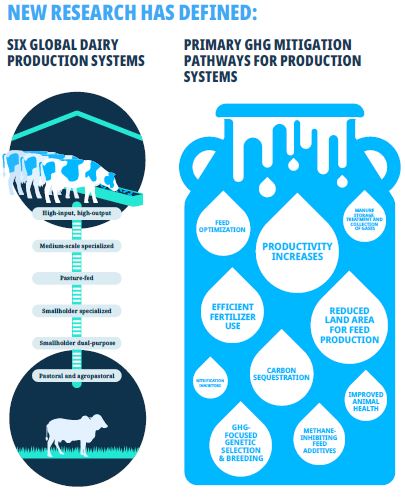P2DNZ Research identifies practical pathways for dairy systems worldwide
P2DNZ Research identifies practical pathways for dairy systems worldwide
Pathways to Dairy Net Zero (P2DNZ) raises dairy’s ambition to accelerate climate action by reducing its greenhouse gas (GHG) emissions, while continuing to provide nutritious foods and livelihoods for billions of people. Research commissioned under the initiative has identified six primary dairy production systems throughout the world, along with potential mitigation options and their estimated impact on reducing emissions.
The research team, led by the Global Research Alliance on Agricultural Greenhouse Gases in close collaboration with the FAO, recognizes that there is significant variability of GHGs emitted by each typology. For example, methane is a large proportion of GHG emissions in pastoral and agropastoral systems, driven largely by enteric fermentation. However, high-input, high-output production emits a different mix of GHGs from not only enteric fermentation but also manure management, animal feed and energy use.
Although the mitigation options will vary by each dairy production system, some of the primary pathways include improving animal health, increasing feed digestibility, enhanced manure management storage and treatment, more efficient fertilizer use and the potential adoption of methane-inhibiting feed additives.
The research will next model the impact on warming of cumulative emissions for each GHG. This work is crucial since each gas has a different effect and unique longevity in the atmosphere. Methane, for instance, though a highly potent GHG, breaks down in the atmosphere in 12 years. Conversely other gases, such as carbon dioxide, can remain in the atmosphere for hundreds of years.
In 2023 the main activity for the research team will be:
- Continuing consultations on typologies, corresponding mitigation pathways and determination of realistic mitigation potential, by typology, by 2050
- Aligning with FAO GLEAM model to give spatial perspective to dairy GHG emissions (case studies and global levels)
- Identify opportunities and barriers to uptake of mitigation pathways (case studies) – use outputs to assist development of spatial modelling (GLEAM)
- Modelling climate impact of each mitigation pathway using MAGICC (model for the assessment of GHG-induced climate change)
For further information on P2DNZ along with how to sign up to show your support for the initiative, please visit the P2DNZ website.

